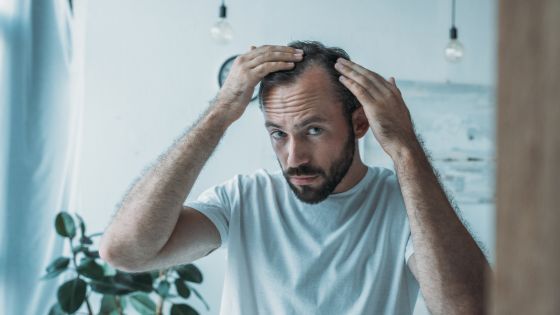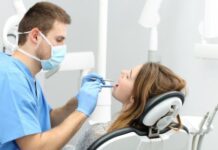Hair loss or alopecia is a common problem that is seen in approximately 72% of men at some point in their lives. Although hair loss can affect anyone, it is more commonly seen in men compared to women. It can affect not just the physical appearance of a man, but could also affect his mental well-being and self-confidence.


It is normal for an individual to lose about 100 strands of hair per day. The hair tends to fall and regrow, and this process continues again. However, when the number of strands of hair that fall in a day increases and the hair does not return, it could lead to permanent hair loss or baldness. Sudden loss of hair could indicate a medical problem that needs treatment. While many men allow hair loss to progress naturally, others may opt to hide it using wigs, caps, cosmetics, or different hairstyles. Some men even try remedies like medications or hair transplants to stop hair loss or encourage its growth.
1. Causes of Hair Loss in Men
Hair loss, whether noticeable thinning of hair or baldness, could happen due to several reasons like medical illnesses, hereditary factors, hormonal imbalances, or aging. The most common causes of hair loss in men are:
2.1 Male Pattern Baldness (Androgenetic Alopecia)
Male pattern baldness, also known as androgenic alopecia, is one of the most common causes of hair loss in men. Genetic factors and the body’s production of male sex hormones (androgens) could result in this condition. The condition may start affecting men in their 20s or 30s and more than 50% of men may notice some amount of hair loss by the age of 49. A man affected by male pattern baldness can notice his hairline begins receding or could notice the beginning of hair loss around the crown of the head or the vertex, known as vertex baldness.
2.2 Family Background (Heredity)
The most common cause of hair loss in men is a hereditary condition that gets worse with age. Most men who have bald spots or receding hairlines have received it as a result of a family history of hair loss. This results in androgenic alopecia.
2.3 Medical Issues and Hormonal Shifts
Several medical conditions, especially hormonal disorders, could result in temporary or permanent hair loss. Some examples of medical conditions that could result in hair loss include ringworm infections of the scalp, an immune system-related condition known as alopecia areata, a hair-pulling disease known as trichotillomania, high blood pressure, thyroid disorders, prostate cancer, and heart disease.
2.4 Head-focused Radiation Treatment
An individual undergoing radiation therapy in the scalp region may prevent the hair from regrowing in the same way as before. The scarring due to radiation treatment may result in permanent loss of hair.
2.5 Stress and Emotional Factors
Many men may notice thinning or loss of hair following some kind of physical or emotional stress, sudden loss of weight, surgery, or even flu and fever.
2.6 Scalp Infections
A scalp infection can lead to scaly and sometimes inflammatory areas on the scalp. Conditions like ringworms could result in bald spots. However, the hair generally grows back following treatment.
2.7 Immune System
Alopecia areata is a genetic condition that leads to sudden loss of hair producing circular or quarter-sized bald spots over the head. Small patches of hair may re-emerge as the immune system of the body starts attacking the hair follicles. Although the hair may regrow, it may also start to fall out again.
2.8 Grooming
Transient hair loss, also called traction alopecia, is a condition that can develop when the hair near the scalp is pulled excessively due to hairstyles like ponytails, cornrows, or braids. Hot oil treatments and perms could also harm the hair follicles.
2.9 Bad Diet
Problems associated with a poor diet, such as a protein-deficit diet, iron-deficit diet, or consumption of excessive Vitamin A may cause transient hair loss.
2.10 Aging
It is normal for hair growth to slow down as age advances. This is because the hair follicles stop producing new hair follicles with age, resulting in thinning of hair on the scalp and eventually hair loss.
2.11 Drugs and Other Supplements
Certain medications, like medicines for cancer, anxiety, arthritis, diabetes, high blood pressure, and heart problems, can lead to hair loss as a side effect.
2. Treatments Available for Hair Loss
Multiple types of hair treatments are available at ALCS Clinic to treat different types of hair loss and hair thinning problems. You can visit ALCS Clinic for a comprehensive health check to assess the cause of your condition and undergo treatment for the same. The different types of treatments offered at ALCS Clinic for hair loss include the following:
3.1 Medications
Certain medications can help in treating hereditary baldness. These medications include:
- Minoxidil: It comes in shampoo, liquid, and foam forms. The product needs to be applied to the skin on the scalp twice daily. Products containing minoxidil can help slow down the rate of hair loss, regrow hair, or both. It may take a minimum of six months of treatment to prevent further loss of hair and for the hair to regrow again.
- Finasteride: It is available in a pill form that needs to be taken daily by men. It may take a few months before men can notice the hair loss slowing down or new hair growth.
- Other medications: Other oral medicines that may be given for hair loss treatment include spironolactone and oral dutasteride.
3.2 Surgery and Other Procedures
Other procedures that could treat hair loss problems include the following:
- Corticosteroid injections: These injections are given by the trichologist, dermatologist, or cosmetic surgeon into the bald or hair-thinning areas every four to eight weeks, as needed.
- Hair transplant surgery: This procedure involves removing hair from a part of the head that has hair and transplanting it to a bald spot. The procedure is usually recommended for people having male pattern baldness.
- Laser therapy: A low-level laser device can be used as a treatment for hair loss. It is a painless and safe procedure but requires multiple treatment sessions.
- Platelet-rich plasma (PRP) treatment: The procedure involves removing a small quantity of the patient’s blood, placing the blood in a machine that separates it into different parts, and injecting a part of the blood (known as plasma) into the hair loss area. Most patients need to undergo this procedure once a month for three months followed by once every three to six months.
3.3 Lifestyle Changes and Home Remedies
The treatment for hair loss will vary depending on the cause of the condition. For example, if a medical condition is causing hair loss, the doctor will treat the medical condition. If hair loss is a result of taking certain medications, the doctor will either stop or replace those medicines. Taking a nutritious diet and avoiding stress can also help in reducing hair loss.
Additionally, hair care methods like tying loose ponytails, choice of a hairstyle that makes bald spots less visible, avoiding harsh chemical hair treatments, use of a wig or extensions, etc. can make hair loss less conspicuous.
3. Conclusion
Hair loss can negatively impact physical appearance and also cause self-esteem issues in men. It can occur due to several reasons like genetics, hormonal imbalances, aging, use of certain medications, stress, poor diet, scalp infections, radiation treatment, harsh hair grooming procedures, or the presence of certain medical conditions.
Hair loss can be treated by making some lifestyle changes, use of certain medications, and surgery or other medical procedures. If you suffer from hair thinning or hair loss, you can contact ALCS Clinic in Jaipur today. We will provide you with a comprehensive hair check, determine the exact cause of your hair loss, and suggest an appropriate treatment for the same. To get in touch with ALCS Hair Transplant & Cosmetic Clinic

























